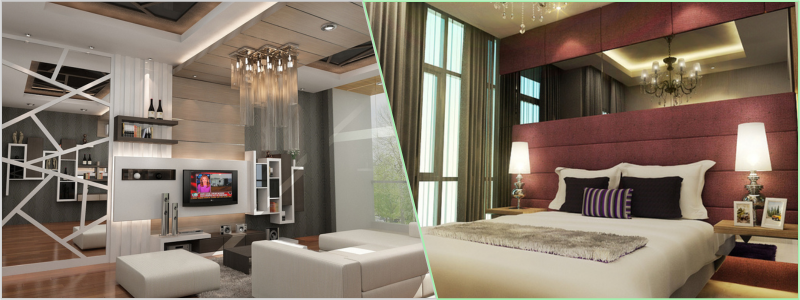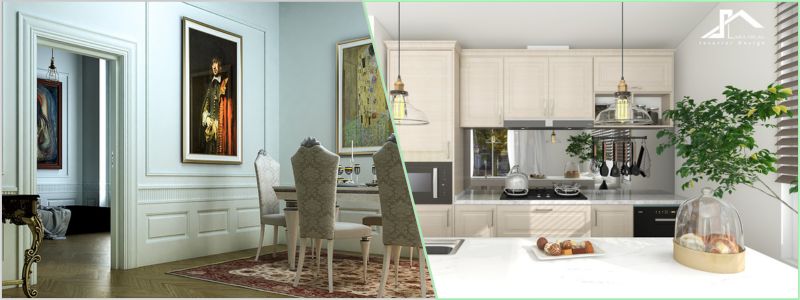This post covers virtual staging for architecture and real estate companies, pricing, rates, and fees. Architects use architectural visualizations to pitch building design ideas and concepts by homeowners and real estate companies when marketing properties online. The visualizations to sell houses are known as virtual staging, in which sellers arrange decorations and furnishings to showcase the property best. As part of the preparation for selling, homeowners or real estate agents may modify the interior appearance with 3D interior design rendering services by adding, replacing, or removing some items digitally. The new look is expected to increase the sale price or attract more potential buyers.
Previously, the only way to transform an architectural space was with actual, physical home staging. Instead of redecorating on a computer screen, sellers rented new sets of furniture and furnishings for the makeover, which could be a risky investment. For example, when buyers and offers were not coming in quickly enough, the rental cost soon built up to a discouraging point and took away a sizable portion of the profit margin – if the house was sold at all. Virtual staging eliminated the hassle and removed the financial burden.
 Table of Contents
Table of Contents
RELATED: How 3D virtual reality is changing the real estate industry
Architectural virtual staging cost
Virtual staging is more like a photo manipulation technique than a full-blown visualization. The process requires sellers to take photos of an empty house (or poorly furnished one) and send them to a 3D CAD drawing and drafting professional for editing. All the new furnishings are 3D models arranged carefully on top of the images to create a photorealistic design. Combining artistic skills and rendering technology can make 3D models virtually indistinguishable from actual physical objects.
A conventional home staging could cost between $1,000 and $3,000 to bring in the furnishings and set up the property, and sellers might need to spend a monthly rental fee of more than $500 for the décor and furniture. Alternatively, the average cost of virtual staging is from $20 to $200, depending on the of photos and 3D models used. Generally, virtual staging should cost roughly 10% of comparable home staging, excluding the monthly rental fee.
RELATED: 5 Reasons your architectural firm should use 3D rendering outsourcing
The furnishings are superimposed on an actual photograph. It does not mean sellers include all the items shown in the render as part of the deal. One significant advantage of the process is that they never have to use or purchase premium 3D assets in the first place. The chairs, tables, paintings, carpets, and cabinets are not for sale; the sole purpose of their existence is to demonstrate how the house looks at its full potential.
When a house is adequately furnished, it helps highlight the property’s spaciousness and general layout. It is not just furniture and decorations; virtual staging can give a home a new look. Advanced photo manipulation techniques can replace wall colors, floor finishes, and light fixtures. Virtual staging for architecture services offer an effective presentation tool for homeowners who want to sell but still currently occupy the property, and it helps buyers see what the house can be rather than what it now is.
RELATED: 7 Industries that have been transformed by 3D rendering services
The workflow is simple:
- The sellers/clients take interior photos of the house they want to market and send them to a qualified virtual staging service or freelancer. Clients must also include additional information, including the size of every room and the whole property, the desired styling, wall colors, and variations. A detailed brief minimizes the chances of mistakes and revisions at a later date.
- The professional evaluates the photos and determines the selection of furnishings to use in the images
- The sellers see the edited photos and ask for revisions if need be
- When there are no more revisions, the final images are once again sent back to the clients
As for the photographs, ask the 3D architectural visualization company you hire for guidance on taking photos for virtual staging purposes. You may have to declutter some rooms or remove the existing decorations first. Ask about the ideal viewing angles, orientation, minimum resolution, and lighting.
RELATED: Working with a 3D home design service – things to consider

Included services in virtual staging
Chances are virtual staging services or freelancers who specialize in the field have access to large repositories of 3D models most commonly used for interior and exterior designs. Whether a client needs a minimalistic, luxurious, industrial, or practical approach to styling, there are always multiple sets of furnishings to cater to the demand. Most 3D models are based on actual products, so buyers can purchase everything. Virtual staging may include the following:
- Furniture replacement: the interior might not be empty, but the styling is outdated or has not been updated for the last decade. Even if some people are interested in buying the property, the out-of-style furnishings can be a dealbreaker. With the help of 3D furniture modeling designers, an otherwise underwhelming design can be transformed into a sought-after home. Photo manipulation and rendering technology offer massive functionalities to erase the existing furniture from the space and replace them with brand-new variants.
- Decoration: some houses look modern and sleek, but the walls and floors appear dull or empty due to the lack of personalized decorations and ornamentations. Adding personal touches in every room may help convince buyers that the homeowner has loved and taken good care of the property. A well-decorated house is a cherished one.
RELATED: How real estate companies use CGI advertising to grow revenue at firms
- Exterior staging: much like 3D exterior rendering services or visualization, the staging process transforms the area immediately surrounding the house into its best possible appearance. Sellers must proceed cautiously with exterior staging because buyers will expect everything shown in the picture to exist in the real world.
Based on the property’s specifications, any exterior staging project is best treated as a 3D exterior rendering task. For example, adding a fountain in the middle of the garden in the visualization is unnecessary if the feature is not there. Unlike with an interior modification where buyers can omit a sofa or TV set, buyers will think that the landscape and swimming pool in the backyard is parts of the deal.
Same house, different decor
Home staging has existed since the early 1970s, whereas virtual staging occurred during the 2007-2009 recession. Photo manipulation techniques used by 3D home rendering professionals helped banks and homeowners transform run-down houses and barren properties into presentable assets without requiring the same massive investment as physical staging. The practice has never been about telling people that their houses are unappealing or inadequate, but it focuses on painting the ideal picture for potential buyers. Apart from the affordability factor, versatility is another excellent benefit of virtual staging.
RELATED: How to create a virtual tour of homes with 3D rendering services
A conventional home staging method can only modify one room (or one house) at a time. In contrast, the digital method can simultaneously apply various styles and designs to a single house. Sellers do not always know what buyers want; some prefer vintage Victorian style, and others prefer contemporary décor. A virtual reality professional has the design know-how and the tools to ensure each style looks photorealistic. It also allows sellers to convert any room in the house; for example, a child’s bedroom can be renovated into an office and vice versa.
They can remove personal decorations that might turn off buyers from the image, like a collection of figurines, walk-in closets, or racks of vintage magazines. On the exterior part, the staging may emphasize the atmosphere, including time of day, weather, season, and landscape. Certain houses with specific colors and architectural styles look best when covered under a thin layer of snow, while others shine better on a summer night or spring morning with lush greenery. The presence of trees in the area and the picture of a clean or organized neighborhood add to the appeal.
Moreover, virtual staging can encourage reluctant sellers to list their properties on the market. If previously they hesitated to put it up for sale because of the flaking paint, dirty furniture, loaded-up garage, or poorly maintained landscape, virtual staging makes everything easier. The process is more private than traditional staging, too. A homeowner takes the photographs and sends them to professionals for processing, to either remove or add details to the interior design. There is no need to have strangers moving around inside the house to stow away family portraits from the wall or a nostalgic couch from the living room.
RELATED: 13 Steps for outsourcing 3D architectural rendering with companies & 3D artists

Virtual staging criticisms
A die-hard criticism of virtual staging mentions that digital 3D visualizer services are a form of false advertising. Some critics think using 3D furnishing models instead of physical objects to increase property prices can be misleading. The critics are not entirely incorrect, so it is helpful that virtual staging professionals are aware of the ethical boundaries.
They may replace old furnishings with a different style and remove artwork, personal portraits, or garbage cans from the exterior. However, they should not erase permanent objects like massive pylons, power lines, or water towers. Given the seller’s instructions, the virtual staging professional creates a virtual 3D interior rendering. Sellers must ensure potential buyers know the property images on the listings have been digitally enhanced to demonstrate how the house can look.
How Cad Crowd can assist
At Cad Crowd, we have the privilege of working with some of the best architectural design freelancers in the world. If you’re looking for help with your project, get in touch with us for a free quote.
